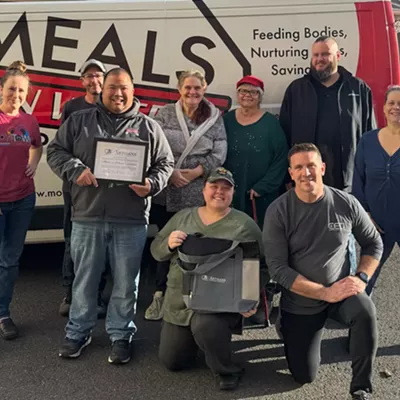Some 77 years after it was first conceived, the North Spokane Corridor project takes the saying "Slow and steady wins the race" literally.
"I've lived in Spokane for seven years now, and I've heard for a long time that 'I'll never see it — it will never be built while I'm alive,'" says Joe McHale, spokesman for the Washington State Department of Transportation. "One thing we really want to let people know is yes, you will."
Construction on the project, which began in 2001 and is better known as the north-south freeway, is underway but faced a setback earlier this year when Gov. Jay Inlsee proposed delaying the project's funding and pushing its completion to 2035.
But this month, the Legislature approved House Bill 1125, which allocates another $169 million to the $1.5 billion project. The appropriations bill passed both the House and Senate last week.
One reason behind Inslee's recommendation to pull funding was a shortfall in the Connecting Washington account, which pays for several major projects including the North Spokane Corridor.
"The funding shortfall is a result of gas tax revenues coming in lower than projected," says state Senate Majority Leader Andy Billig, D-Spokane. "There is less money coming in from gas tax to pay for projects, as compared to the amount the Legislature expected to have when it programmed all of these improvements."
However, Billig says it was important to allocate the necessary funds to the North Spokane Corridor.
"This is a project that's already partially built, and we need to finish what we started," he says.
FROM 29 INTERSECTIONS TO NONE
State Sen. Marko Liias, D-Everett, says that currently the project will likely be finished by around 2030, which is the blink of an eye when it comes to infrastructure projects like this.
"A project of this magnitude and complexity, and all of the environmental review and design that needs to take place and then having construction, it just takes time to get it all done," he says.
Ultimately, the corridor will connect both U.S. Route 395 and U.S. Route 2 to I-90 near Freya Street. When complete, transportation officials say the new 10.5-mile freeway will reduce traffic on the Division Street corridor.
"Part of the promise of the North Spokane Corridor is to take traffic, and particularly truck traffic, off of Division so that we can transform Division into a much more productive, effective and aesthetically pleasing corridor," says Billig.
According to Terrence Lynch, WSDOT's North Spokane Corridor project engineer, the freeway will remove cars from Division and reduce congestion created by the major road's 29 intersections, consequently reducing travel times and vehicle emissions caused by crawling traffic.
"Our traffic modeling shows somewhere in the neighborhood of 65,000 vehicles or trips a day on the freeway, and that's both directions once it's completed," Lynch says. "If you think about that many trips and taking those particular trips off of the local system, that's a significant reduction."
FORCED TO DRIVE
Major cities across the U.S. have spent trillions of dollars expanding highways and constructing new ones in an attempt to reduce traffic on major roads or freeways — with questionable results.
At a 2018 meeting of American Association of State Highway and Transportation Officials, Roger Millar, who leads WSDOT, said building and expanding highways to solve congestion "isn't the answer," and congestion "is a problem we simply cannot solve."
"We like to talk about traffic congestion as an issue, but it is actually a symptom of a larger problem — and the problem is we don't provide affordable housing and transportation solutions," he said, according to the AASHTO Journal. "We have a rich list of transportation options for the rich that can afford to live in our cities — the rest are forced to drive."
Not to mention the fact that these projects work temporarily, and the traffic and sluggish travel times tend to return shortly. This phenomenon is known as "traffic generation" by planners, and "induced demand" by economists.
As Millar suggested, a better solution would be to fund transit or other non-automobile transportation.
According to Billig and Liias, $50 million in state funds have been added to the city's transportation budget to transform the Division corridor and include bus rapid transit, bike and pedestrian facilities, and a variety of different amenities and housing options.
"One of the really big benefits is that we are going to transform Division from what I think is a fairly problematic corridor into something that's going to be really special," Billig says.
Another component of the project is an effort originally led by Billig and Sandy Williams, publisher of the Black Lens newspaper who died in a plane crash last year, to determine how to use surplus property from the project in a way that gives back to the East Central community.
"Had the project been built decades ago, I don't have confidence that it would have been built with deep community engagement," says Liias. "I was really impressed with the level of engagement with individual communities and engaging them in sort of what is your vision for the project, not just what is the most efficient engineering vision."
Where the north-south freeway will eventually meet I-90 is currently the site of Camp Hope, a large homeless encampment. WSDOT is currently seeking feedback on designing a ramp there, where the north-south freeway's "skyway" — a 60-foot-tall section of the highway that will stretch from Spokane Community College to I-90 — meets the interstate.
"I actually got to get up on the deck of the new freeway; they were constructing it last summer," says Liias. "It was pretty powerful to stand there and imagine what it'll be like when it's done in a few more years." ♦

























